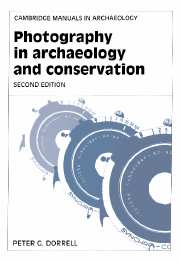Book contents
- Frontmatter
- Contents
- List of illustrations
- Preface
- Preface to the second edition
- Acknowledgements
- 1 The early days of archaeological photography
- 2 Basic principles and practice
- 3 Equipment
- 4 Lighting by flash
- 5 Photographic materials, processing and printing
- 6 Architecture and standing monuments
- 7 Survey photography
- 8 Site photography
- 9 Principles of object photography
- 10 Principles of close-up photography
- 11 Ultra-violet and infra-red photography
- 12 Photographing finds
- 13 Flat copy
- 14 Preparation of material for publication
- 15 The future
- References
- Index
5 - Photographic materials, processing and printing
Published online by Cambridge University Press: 23 December 2009
- Frontmatter
- Contents
- List of illustrations
- Preface
- Preface to the second edition
- Acknowledgements
- 1 The early days of archaeological photography
- 2 Basic principles and practice
- 3 Equipment
- 4 Lighting by flash
- 5 Photographic materials, processing and printing
- 6 Architecture and standing monuments
- 7 Survey photography
- 8 Site photography
- 9 Principles of object photography
- 10 Principles of close-up photography
- 11 Ultra-violet and infra-red photography
- 12 Photographing finds
- 13 Flat copy
- 14 Preparation of material for publication
- 15 The future
- References
- Index
Summary
For conservation and post-excavation work generally, processing equipment and a reasonably convenient darkroom are necessary facilities. Museums and similar institutions will normally have the back-up of a photographic department, and perhaps even the luxury of a technical staff, although for some a temporary darkroom and the simplest equipment will have to suffice. Similarly, some digs may be within reach of a base with a fully-equipped darkroom while others may have to manage with the minimal facilities that can be contrived on site. But while the photographic requirements of a museum or conservation department will probably be assessed in terms of space, personnel and budget, the decision whether or not to process film on an excavation site involves other considerations. As well as the requirements of extra equipment, materials and space, and the occasional diversion of personnel from tasks that may appear more urgent, there is the fundamental question of the quality of the record.
In the field, it is a principle that no structure or artifact should be destroyed or removed until it has been fully recorded; this means, so far as the photographic record is concerned, until at least the film is developed and checked as being technically satisfactory and as showing whatever is necessary. This principle is disregarded often enough for colour film, otherwise delays might be intolerable, but it should not be lightly abandoned so far as black and white negatives are concerned, since these are often the primary, and sometimes the only, record of a structure.
- Type
- Chapter
- Information
- Photography in Archaeology and Conservation , pp. 65 - 95Publisher: Cambridge University PressPrint publication year: 1994



